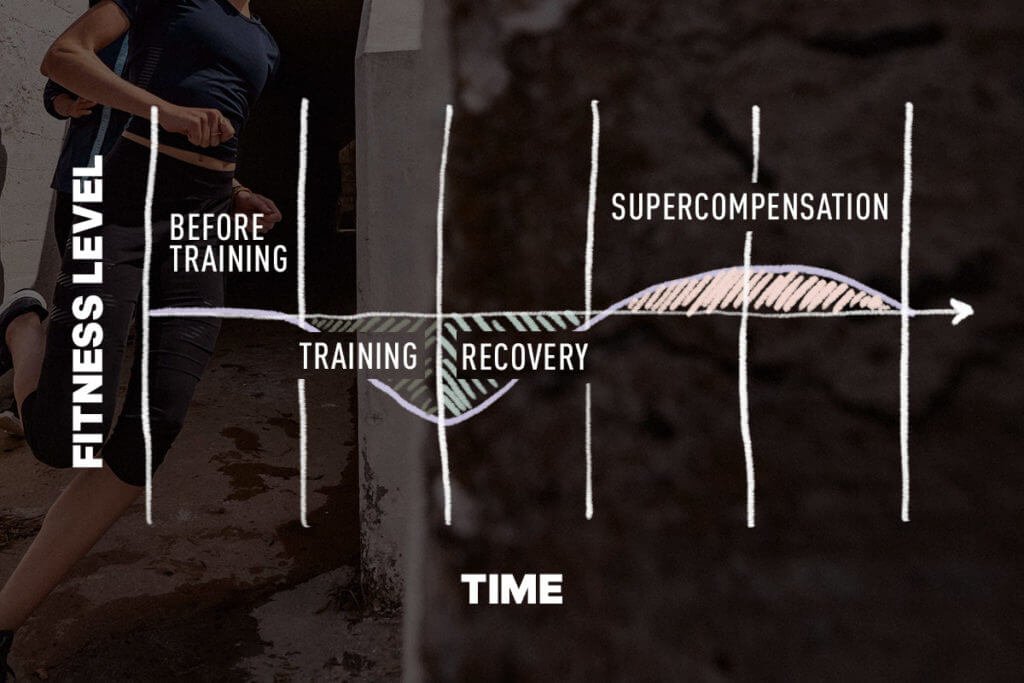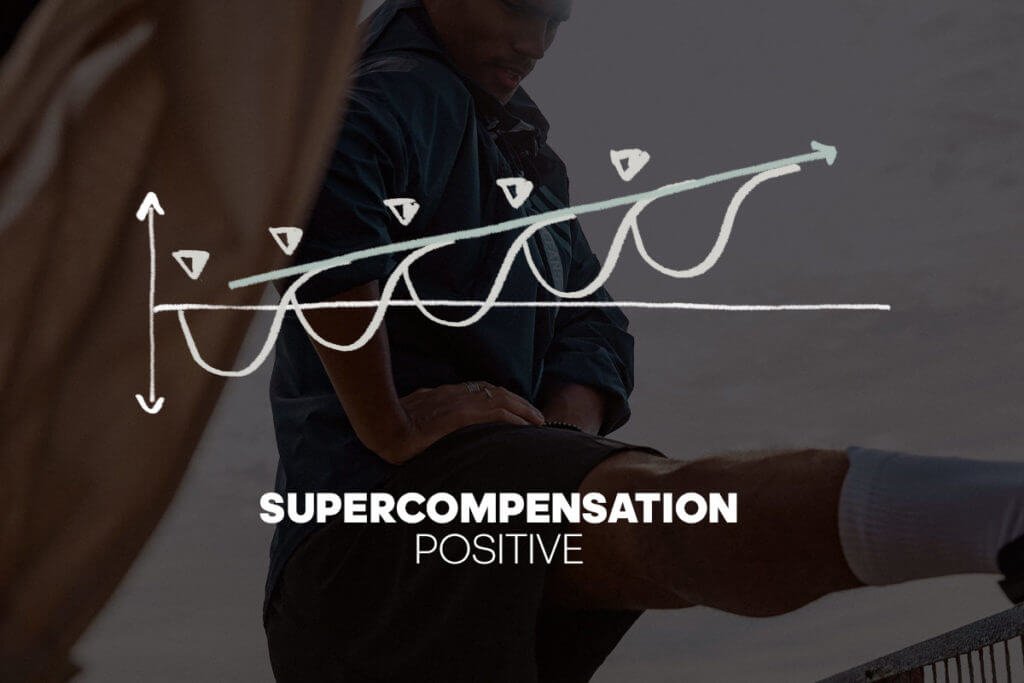Absorbing the Training
When it comes to training we have 2 main principles: stress and rest. When we apply enough stress to our body we adapt or get a training response. If you apply too much stress too often you can over train or injure yourself. So then how do we know what “enough” is? What’s the best way to determine if your training is effective?
The Basics
Your training should have a logical progression - increasing intensity and mileage for a number of weeks before a down week. This process of taking the down week and protecting it is the whole point of this article. But why? Why do we need to take a down week if our bodies will adapt to the stimulus anyway? Why not train at say 80-90% instead of always reaching above? Wouldn’t it be more sustainable? To fully understand this we need to dive into the idea that through training we set a new baseline when we apply stress, as long as we recover properly.
Supercompensation
It’s the first and most important principle of training for athletes and coaches to train and embrace. You can see that we must apply stress or “training” and recover to lift our baseline. Now if you were to take the picture above literally you’d think that super compensation returns you to your prior baseline. While you surely can recover completely from a stimulus you’ll likely continue to build which means you’d never make it to the 5th vertical bar and rather start building again from the 4th bar.
What used to tire me doesn’t
Think about doing 6x 400m at 7:30/ mile on 60 seconds rest; early in a cycle that workout might be extremely difficult for an athlete. So how do we get the athlete faster?
Run 6x 400m at 7:30 again the next week?
Run 4x 800m the next week?
Try to run 6x 400m at 7:15 with 90 seconds rest the next week?
That’s what makes up coaching! What’s the bigger goal? are you training to run 6x 400m, a 5K, a marathon? The workout doesn’t matter nearly as much as what you’re pointing your fitness towards! The next workout or “stimulus” / “stress” is based on where we’re heading and what adaptations your body needs to make to perform a specific task.
To truly improve your 6x 400m time, you’d want workouts that help you manage that 7:30 pace more efficiently.
This could be a longer long run so you have more aerobic capacity
This could be reps longer that 400m at a slower pace to build your ability to manage paces closer to 400m
This could be shorter reps faster than your 400m pace to build leg speed and other physiological components
The Micro Level of Supercompensation
Think of your weekly training schedule:
Monday Aerobic Run
Tuesday Workout
Wednesday Off
Thursday Aerobic Run
Friday Workout
Saturday Off
Sunday Long Run
Where is the recovery stimulus? Where do you absorb the training?
Wednesday and Saturday allow you to recover from your workouts and the prior days aerobic work.
What if I don’t take days off?
You’ll continue to tire. You’ll start seeing performance drop off and it will become harder to hit splits and times you could hit weeks earlier.
Stairsteps
We looked earlier at the micro level of supercompensation. How do we look at a single week of training? Where do we absorb the training? Is it always seen as a day off? Any good coach will answer this with “it depends”. For athletes that have been training for a long period of time following sound training principles - a recovery day could look like an 8 mile aerobic run. That 8 mile run is a small enough portion of their weekly mileage at a low aerobic pace that it won’t exhaust them and won’t accumulate more waste. In fact, they’re so fit that they need at least 8 miles to maintain their current fitness. To get to this level of fitness they had to go through numerous periods of supercompensation. This brings us to our 2nd most important training principle.
Periodization
Periodization can be viewed as the macro level of super compensation. Let’s take a really big look at training and break down a 16 week block. What we must agree on first is that supercompensation happens at every time span of training: daily, weekly, and monthly. When we think of it at a weekly level we think of the recovery phase as a “rest week”, at the greatest level we could call a month of light training our “off-season”.
16 Week Build Up ( Mileage View)
Period 1: Weeks 1-4
Week 1 - 40 miles
Week 2- 44 miles
Week 3- 47 miles
Week 4 - 44 Miles (recovery week)
Period 2: Weeks 4-8
Week 1 - 47 miles
Week 2- 52 miles
Week 3- 55 miles
Week 4 - 48 Miles (recovery week)
Period 3: Weeks 8-12
Week 1 - 52 miles
Week 2- 57 miles
Week 3- 60 miles
Week 4 - 55 Miles (recovery week)
Period 3: Weeks 8-12
Week 1 - 58 miles
Week 2- 62 miles
Week 3- 48 miles
Week 4 - 40 Miles (Race?)
How a periodization is built
The above shows a 3:1 Periodization where we build up for 3 weeks (40, 44, 47) and come down for 1 (44). That week of 44 miles wouldn’t be nearly as difficult as 47 miles you ran the week before. Therefore, you’ve adapted to at least 44 miles. For masters athletes that need more recovery 2 things must change 1) Masters athletes need more time to recover so a 2:1 periodization favors less training stress duration (in weeks) 2) Given the loss of 1 week of build in a 2:1 periodization, most masters athletes need to build for 20 weeks to get to the same level as a 16 week plan.
Focus on the rest week
The rest week is the red shaded portion in image 1. This is when you’re getting more rest and the stimulus in that week is not breaking you down as much as weeks prior. If you don’t take that week you’ll continue to drill down in the training phase. Which if you dig for long enough and try to take a rest week, you won’t break the horizon. If you overtrain you’ll need multiple rest weeks to recover. This delicate balance is more than just stress / rest. It’s also a function of how you recover.
How do we absorb the Training?
Fuel, Sleep, Low Aerobic Work, Body Work - Down periods
If we had to pick just one way to improve your recovery time dramatically, it would be to increase the hours you sleep. There is no tool in your arsenal more powerful than a good nights sleep and an afternoon nap when you’re training your body to new levels. You also cannot out train a poor diet that isn’t fueling you enough or fueling you correctly. If you are struggling to properly recover, you’ll likely be unable to perform hard workouts that apply addition stress beyond baseline. Your best bet when you have lots of external stress (work, family, life) is to default to aerobic work that you can recover from. There is nothing wrong with maintaining your fitness during periods of high stress! Taking care of your muscles is a big priority but is often prioritized over nutrition and sleep. We’ll talk more about active and passive recovery in a future piece but what’s most important to understand is this: Sleep and Nutrition beat out every other type of recovery stimulus by a massive margin. Your sleep and nutrition determine your success far more than the quality of your workouts.
Going into a race 100% trained and 80% recovered will likely yield an underperformance compared to the athlete who shows up 80% trained and 100% recovered. The latter has a bigger well to draw from, the under recovered athlete is running dry with 20% of the race still to go. Where do you think the biggest moves are made in a race - the first 20% or the last?
Want More?
We have numerous articles to help you fully optimize your training and help you go to the next level. If you’re looking for a great coach you can learn all about our staff and what they specialize in to help you have your best race day ever.


